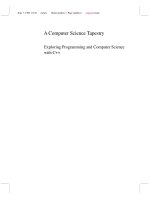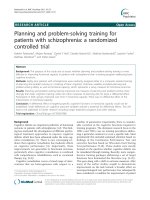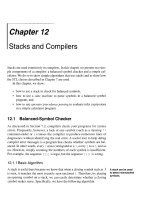programming and problem solving with c++ 6th by dale ch12
Bạn đang xem bản rút gọn của tài liệu. Xem và tải ngay bản đầy đủ của tài liệu tại đây (575.5 KB, 49 trang )
Chapter 12
Classes and
Abstraction
Chapter 12 Topics
Meaning of an Abstract Data Type
Declaring and Using a class Data Type
Using Separate Specification and
Implementation Files
Invoking class Member Functions in Client
Code
C++ class Constructors
Abstraction
Abstraction is the separation of the
essential qualities of an object from the
details of how it works or is composed
Focuses
on what, not how
Necessary
for managing large, complex
software projects
Control Abstraction
Control abstraction separates the
logical properties of an action from its
implementation:
Search (list, item, length, where, found);
The function call depends on the
function’s specification (description),
not its implementation (algorithm)
Data Abstraction
Data abstraction separates the
logical properties of a data type from
its implementation
LOGICAL PROPERTIES
What are the possible values?
What operations will be needed?
IMPLEMENTATION
How can this be done in C++?
How can data types be used?
Data Type
set of values
(domain)
allowable operations
on those values
FOR EXAMPLE, data type int has
domain
operations
-32768 . . . 32767
+, -, *, /, %, >>, <<
Abstract Data Type (ADT)
An abstract data type is a data type whose properties
(domain and operations) are specified (what)
independently of any particular implementation (how)
For example . . .
ADT Specification Example
TYPE
Time
DOMAIN
Each Time value is a time in hours, minutes, and
seconds.
OPERATIONS
Set the time
Print the time
Increment by one second
Compare 2 times for equality
Determine if one time is “less than” another
Another ADT Specification
TYPE
ComplexNumber
DOMAIN
Each value is an ordered pair of real
numbers (a, b) representing a + bi
Another ADT Specification, cont...
OPERATIONS
Initialize the complex number
Write the complex number
Add
Subtract
Multiply
Divide
Determine the absolute value of a complex number
ADT Implementation
ADT implementation
Choose
a specific data representation
for the abstract data using data types
that already exist (built-in or
programmer-defined)
Write functions for each allowable
operation
Several Possible Representations
of ADT Time
3 int variables
10
45
27
3 strings
“10”
“45”
“27”
3-element int array
10
45
27
Choice of representation depends on time,
space, and algorithms needed to implement
operations
Some Possible Representations
of ADT ComplexNumber
struct with 2 float members
-16.2
.real
5.8
.imag
2-element float array
-16.2
5.8
C++ Data Types
simple
integral
enum
structured
floating
array struct union class
char short int long bool
float double long double
address
pointer
reference
class Time Specification
// Specification file (Time.h)
class Time
{
// Declares a class data type
// does not allocate memory
class Time Specification
public :
// Five public function members
void Set (int hours , int mins , int secs);
void Increment ();
void Write () const;
bool Equal (Time otherTime) const;
bool LessThan (Time otherTime) const;
private :
};
// Three private data members
int hrs;
int mins;
int secs;
C++ classType
Facilitates re-use of C++ code for an ADT
Software that uses the class is called a
client
Variables of the class type are called class
objects or class instances
Client code uses class’s public member
functions to manipulate class objects
Client Code Using Time
#include “time.h”// Includes specification of the class
using namespace std;
int main ()
{
Client Code Using Time
Time currentTime; // Declares two objects of Time
Time endTime;
bool done = false;
currentTime.Set (5, 30, 0);
endTime.Set (18, 30, 0);
while (! done)
{ . . .
currentTime.Increment ();
if (currentTime.Equal (endTime))
done = true;
};
}
class type Declaration
The class declaration creates a data
type and names the members of the
class
It
does not allocate memory for
any variables of that type!
Client
code still needs to declare class
variables
Remember …
Two kinds of class members:
1) data members and
2) function members
Class members are private by default
Remember as well . . .
Data members are generally private
Function members are generally
declared public
Private class members can be
accessed only by the class member
functions (and friend functions), not
by client code
Aggregate class Operations
Built-in operations valid on class objects
are:
Member selection using dot (.) operator ,
Assignment to another class variable
using (=),
Pass to a function as argument
(by value or by reference),
Aggregrate class Operations
Built-in operations valid on class objects a
also:
Return as value of a function
Other operations can be defined as class
member functions
Separate Specification and Implementation
// Specification file “time.h”
// Specifies the data and function members
class Time
{
public:
. . .
private:
. . .
};









